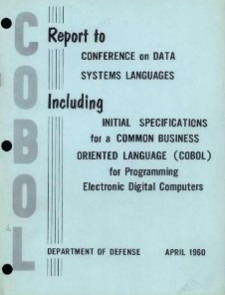COBOL stands for “common business-oriented language.” It is a programming language chiefly focused on solving a business problem. It is primarily used in private company and government businesses, finance, and administrative systems. It is also used as a solution to several data processing problems.
COBOL is still used in applications on mainframe computers, such massive amounts of batch processing and transaction processing jobs.
Many decades ago, each computer maker used its own programming language to tell a computer exactly what to do. A group of programmers named CODASYL (Conference/Committee on Data Systems Languages), devised and introduced COBOL in 1959. The members of CODASYL included people from academic, user groups and computer manufacturers. CODASYL’s main objective was to develop a standard programming language that could be used on several computers, and their efforts led to the development of COBOL.
Programs written in COBOL could run on more than one manufacturer’s computer. A year later, in a test, the same COBOL programs ran successfully on a couple of computers built by different computer makers. Both government and private businesses needed to maintain payrolls, plan budgets, and track property and conventional business data processing aspects. The Department of Defense took an interest in COBOL as it was one of the first few organizations that acquired computer units from different manufacturers. Not long after, COBOL was quickly adopted by other companies, including IBM, who announced COBOL as their new primary development language. Additional programming languages, such as ALGOL and the standard forms of FORTRAN, were developed by engineers and scientists.
The 1965 version of COBOL was introduced that allowed facilities to handle mass storage data files and tables. In 1968, the first ANSI version of COBOL was developed and approved. Since that time, all major computer manufacturers and software makers provided compliers that adhered to the language formats specified in the ANSI version of COBOL. By the early 1970s, COBOL had become the most widely used programming language in the world.
In 1974 a new COBOL version was developed and approved to make it even more efficient and standardized. In 1985, the third version of COBOL was developed – and this is the version that is presently being implemented. It is a significant improvement compared to the previous versions, increasing the versatility and structure of the language.
COBOL is an imperative and procedural programming language. But in 2002, the first object-oriented COBOL was introduced was first released, and since then, it is also considered as an object-oriented programming language.
Despite the presence of newer programming languages (and their success), it looks like that they can never dislodge COBOL from its position in the market. More recently, Visual Basic and Java have proved to be quite a challenge for COBOL, but the latter is still widely implemented and remains the dominant language in the market. In a survey conducted by Computerworld in 2012, over 60% of organizations were still using COBOL. In 2014, COBOL introduced new features, such as Method overloading and Dynamic capacity tables.
Here are the following versions of COBOL:
- COBOL-60
- COBOL-61
- COBOL-65
- COBOL-68
- COBOL-74
- COBOL-85
- COBOL-2002 (object-oriented COBOL)
- COBOL 2014
COBOL applications can be massive, typically with over a million lines of codes. In addition, COBOL applications are very long-lived. Due to the huge investment in building COBOL applications of over a million code lines, these applications cannot be neglected whenever a new programming language is introduced (and becomes popular) in the market. This is why business applications between ten and 30 years old are still common.
Advantages of COBOL:
- It is a simple language
- It can be used as a self-documenting language
- It can handle massive amounts of data processing
- It is one of the primarily used high-level programming languages
- It is compatible with previous versions
- In COBOL, bugs and other related issues are easily resolved as it has an efficient error message system
- COBOL instructions can be coded in plain English words
Disadvantages of COBOL:
- The syntax can be too wordy
- It has the most rigid format
- It is not designed to handle scientific applications
- The time required to compile a COBOL program is greater compared to machine-oriented programming languages
COBOL was originally written for short-range applications. However, COBOL proved to be so useful that it dominated the majority of government and corporate business data processing for several decades. For instance, COBOL is still being widely used in processing millions of banking transactions daily. The use of COBOL and other common programming languages became standard, leading to the emergence of a thriving independent software industry.

